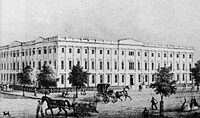The General Post Office Building was located on E Street between 7th and 8th Streets NW. “The Post-office is certainly a very graceful building. It is square, and hardly can be said to have any settled front or any grand entrance,” wrote British novelist Anthony Trollope in 1861. “It is not approached by steps, but stands flush on the ground, alike on each of the four sides. It is ornamented with Corinthian pilasters, but is not over-ornamented. It is certainly a structure creditable to any city. The streets around it are all unfinished; and it is approached through seas of mud and sloughs of despond, which have been contrived, as I imagine, to lessen, if possible, the crowd of callers, and lighten in this way the overtasked officials within. That side by which the public in general were supposed to approach was, during my sojourn, always guarded by vast mountains of flour barrels. Looking up at the windows of the building, I perceived also that barrels were piled within, and then I knew that the Post-office had become a provision depot for the army.”1
President Lincoln raised flag here at a May 22, 1861 dedication. According to a report by the New York Herald, the President responded to the audience’s enthusiastic greeting with a brief and noncontroversial statement: “Permit me to say in response to your invitation that I am very happy, upon this, as upon all occasions, to be an humble instrument in forwarding the very worthy object which you have expressed. I therefore shall take pleasure in performing the part assigned me upon this occasion, and I hope in a satisfactory manner. I suppose that extended remarks are not expected of me at this time, but that it is desired by all that we shall proceed at once to the work in hand, of raising our glorious national ensign to the proud and lofty eminence from which it is designed to have it wave. I am now ready to perform my part.” At first, the flag hung limp against the poll, but a stiff breeze emancipated the flag and allowed it fly freely.2
Journalist Lawrence A. Gobright recalled once the flag waved in the wind: “The effect was electric. The host of spectators, together with the President and the Cabinet, all United in cheers.” Gobright recalled: “I myself, or rather my hat, was rapturously applauded on that occasion. It happened thus: I went there to report the proceedings. The crowd below could not see the window from which persons passed to the platform. Cries had been made for ‘Lincoln:” and, just about that time, I was on the point of stepping upon the platform, to take a seat, when, my hat only being seen by the crowd beneath, they evidently thought that the hat belonged to the President, and that it was on the President’s own head! The applause was deafening. I made no bow of acknowledgment, but quietly stepped back into the room.”3 According to the Herald reporter:
The ropes attached to the staff, and on which the flag was fastened, were then placed in the hands of the President, when, amid the most deafening applause from the crowd below, the flag was raised to its prominent position. There being but a slight breeze at the time of its reaching its place at the top of the staff, it remained for a moment or two motionless, when suddenly, a gentle wind rising from the north, its ample folds were extended to the breeze in a most graceful and beautiful manner, eliciting one universal outburst of applause from the assembled multitude, which was kept up for some time, as the flag continued saving its fold, extending in the direction of the South, as if offering to ensure protection to the advocates and upholders of the government and principles of which it was emblematical in that section of the country. This happy incident had the effect of eliciting the following appropriate from the President:–
LADIES AND GENTLEMEN–I had not thought to say a word, but it has occurred to me that a few weeks ago the ‘Stars and Stripes’ hung rather languidly about the staff all over the nation. So, too, with this flag, when it was elevated to its place. At first it hung rather languidly, but the glorious breeze came, and it now floats as it should. (Cries of ‘Good,’ and applause) And we hope that the same breeze is swelling the glorious flag through the whole nation.4
The 1864 Stranger’s Guide-book to Washington City reported that “This is one of the finest buildings in Washington. It occupies the whole square between E and F and Seventh and Eighth streets, the position being a very central one. The erection of the edifice was commenced in 1839, Mr. Robert Mills being the architect; and in 1855 it was extended under the direction of Mr. Walter. It is built of white marble. The style is what is known as the Palatial, and the order of architecture is a modified Corinthian. The building rests on a rustic basement, and is three stories high. Length from north to south, 800 feet. Depth from east to west, 20.4 feet.”5
Footnotes
- Anthony Trollope, North America, p. 309.
- Roy P. Basler, editor, Collected Works of Abraham Lincoln, (CWAL), Volume IV, pp. 382-383 (from New York Herald, May 23, 1861).
- Lawrence A. Gobright, Recollection of Men and Things at Washington During the Third of a Century, p. 326.
- Basler, CWAL, Volume IV, p. 383 (from New York Herald, May 23, 1861).
- T. Loftin Snell, The Stranger’s Guide-book to Washington City, p. 27.
Visit








